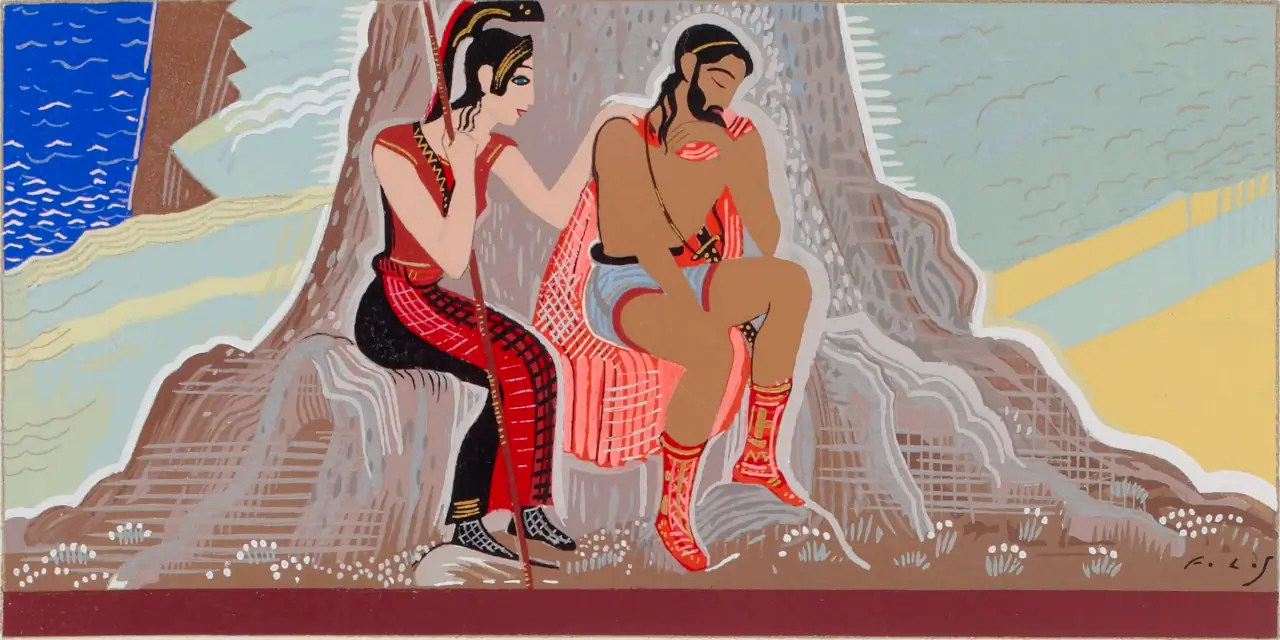τόσσον ἔνερθ᾽ ὑπὸ γῆς, ὅσον οὐρανός ἐστ᾽ ἀπὸ γαίης:
τόσσον γάρ τ᾽ ἀπὸ γῆς ἐς Τάρταρον ἠερόεντα.
ἐννέα γὰρ νύκτας τε καὶ ἤματα χάλκεος ἄκμων
οὐρανόθεν κατιὼν δεκάτῃ κ᾽ ἐς γαῖαν ἵκοιτο:
ἐννέα δ᾽ αὖ νύκτας τε καὶ ἤματα χάλκεος ἄκμων
ἐκ γαίης κατιὼν δεκάτῃ κ᾽ ἐς Τάρταρον ἵκοι.
τὸν πέρι χάλκεον ἕρκος ἐλήλαται: ἀμφὶ δέ μιν νὺξ
τριστοιχεὶ κέχυται περὶ δειρήν: αὐτὰρ ὕπερθεν
γῆς ῥίζαι πεφύασι καὶ ἀτρυγέτοιο θαλάσσης.
as far beneath the earth as heaven is above it,
that is how far it is from earth to Tartaros:
since a bronze anvil falling from heaven to earth
for nine days and nights would land on the tenth,
and a bronze anvil falling from earth to Tartaros
for nine days and nights would land on the tenth.
Around it runs a bronze fence, beyond which night
pours in three rows like a collar, while above it
grow the roots of earth and the barren sea.
(Hesiod, Theogony 720–8, as translated—hopefully not too badly!—by yours truly. Note that the translation is, alas, not line-for-line due to word order considerations.)
ἤ μιν ἑλὼν ῥίψω ἐς Τάρταρον ἠερόεντα
τῆλε μάλ’, ἧχι βάθιστον ὑπὸ χθονός ἐστι βέρεθρον,
ἔνθα σιδήρειαί τε πύλαι καὶ χάλκεος οὐδός,
τόσσον ἔνερθ’ Ἀΐδεω ὅσον οὐρανός ἐστ’ ἀπὸ γαίης:
or I will pick him up and throw him into murky Tartaros
very far away, where the deepest abyss lies under the earth,
surrounded by iron gates and a border of bronze,
as far beneath Hades as heaven is above the earth;
(Zeus speaking. Iliad VIII 13–16, as translated—hopefully not too badly!—by yours truly.)
Ἔστι μὲν οὖν ἡ πορεία διττὴ πᾶσιν ἢ ἀναβαίνουσιν ἢ ἄνω ἐλθοῦσιν· ἡ μὲν γὰρ προτέρα ἀπὸ τῶν κάτω, ἡ δέ γε δευτέρα, οἷς ἤδη ἐν τῷ νοητῶ γενομένοις καὶ οἷον ἴχνος θεῖσιν ἐκεῖ πορεύεσθαι ἀνάγκη, ἕως ἂν εἰς τὸ ἐσχατον τοῦ τόπου ἀφίκωνται, ὃ δὴ τέλος τῆς πορείας ὂν τυγχάνει, ὅταν τις ἐπ' ἄκρῳ γένηται τῷ νοητῷ.
There are two stages of the journey for all, one when they are going up and one when they have arrived above. The first leads from the regions below, the second is for those who are already in the intelligible realm and have gained their footing There, but must still travel till they reach the furthest point of the region; that is the "end of the journey," when you reach the top of the intelligible.
(Plotinus, Enneads I iii "On Dialectic" §1, as translated by A. H. Armstrong.)
The poets describe three worlds: heaven, earth, and Tartaros. We see three worlds in the mysteries, too; heroes always descend twice and reascend twice:
- Osiris is stuffed in a box, then dismembered; in early versions of the Horos-myth (e.g. Shabaka Stone 7–9; cf. Pyramid Texts 770b?, 2099a?), Horos wins the trial to reclaim Lower Egypt, then defeats Seth to reclaim Upper Egypt.
- Perseus is exiled from Argos to Seriphos, and is sent from Seriphos to the ends of the earth; he returns to Seriphos with the Gorgon's head, and returns to Argos as king.
- Persephone is kidnapped from Nusa, then fed the pomegranate seeds to bind her to Hades.
- Hesiod (Theogony 793–804) says that souls which perjure their oaths to the Stux suffer two punishments: they lie comatose for a year, then they are exiled for nine.
- Odusseus returns from Troia aimlessly in his own ship, then directly in the ships of others.
- Zephyr carries Psyche to Eros's palace, the river carries Psyche to earth; as penances, Psyche wanders the earth aimlessly, then Psyche completes tasks for Venus.
- Plotinus says that there are two stages in everyone's upward journey: the ascent from the lower world, and the traversal of the upper world to its highest point.
Therefore I think the poets' "heaven" is the Intellect; "earth" is the world of Soul, the abode of angels and purified souls; and "Tartaros" is our material world, the haunt of daimons and men and beasts, a dark prison surrounded by walls of bronze and gates of iron. Indeed, Homer's shades are insensate because most of us, the inhabitants of Hades, are passive, sheep-like. Teiresias alone among them has his wits because, by the gift of Persephone (that is to say, having mastered the mysteries), he is awake to his seven lives (his reincarnations) and has learned from them, becoming a purified soul, a saint, a hero; he sits in Hades merely waiting for his sentence to be commuted.
So, the heroes' two falls are the emanation from the Intellect and the fall into matter; their two returns are their waking up from the material world (which is relatively brief, if one makes the effort, but very unpleasant) and their efforts to master of the spiritual world (which takes long ages of time but is nicer).
But this also explains another thing that's always bothered me. After Zeus deposes Kronos, he and his brothers share power amongst themselves: Zeus became king of heaven; Poseidon, king of the sea; and Hades, king of the underworld. Since I've mostly followed the four-fold Empedoclean model, the three divisions confused me. The poets' model, however, fits it nicely: Zeus ruling (and being) the Intellect, Poseidon ruling the spiritual world (being Soul), and Hades ruling the material world (being Nature). This explains their traditional attributes, with Zeus being the strongest (because the Intellect has power over all existence), Poseidon being a shapeshifter (because spiritual things are without form), and Hades being wealthy (containing all material things); further, the gifts of the Circle-Eyes are the representation of an individual each at each level: Zeus's lightning-bolts represent the ideas held within the Intellect (hence is a symbol of intuition), Poseidon's trident represents the souls held within Soul (hence is a symbol of reason—a trident grabs a fish much better than a spear, just like reason helps us hold onto intuitive insights—and is, perhaps, why Plato insisted on a tripartite soul), and Hades's dogskin represents the bodies held within Nature (hence is a symbol of sensation and is why Apollodoros says that "it allows one to see while not being seen," a riddling way of describing how a body grants sense-perception while also hiding the soul). This last amuses me: what is a body, after all, but a beast skin wrapped around the soul?

